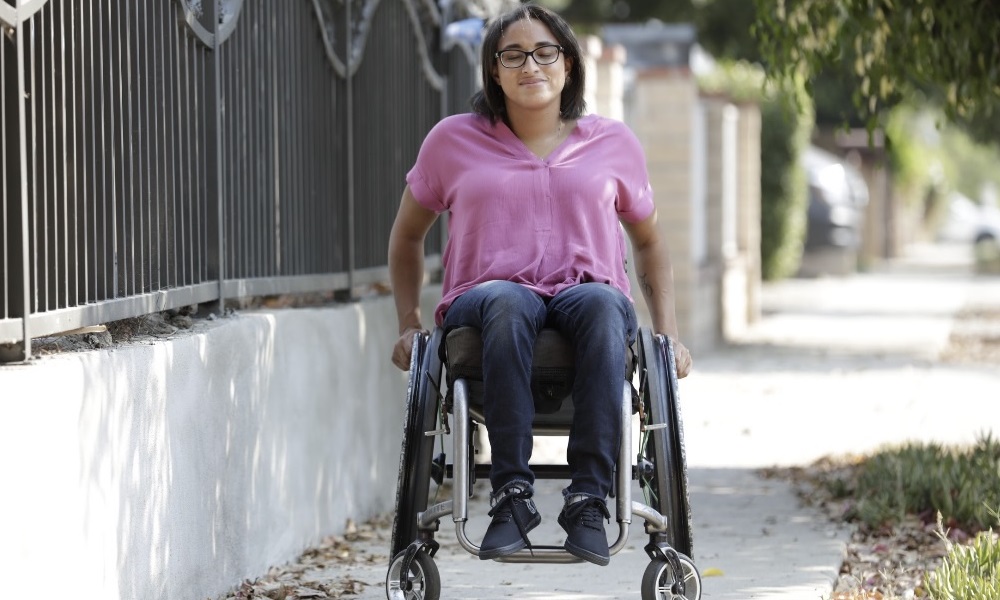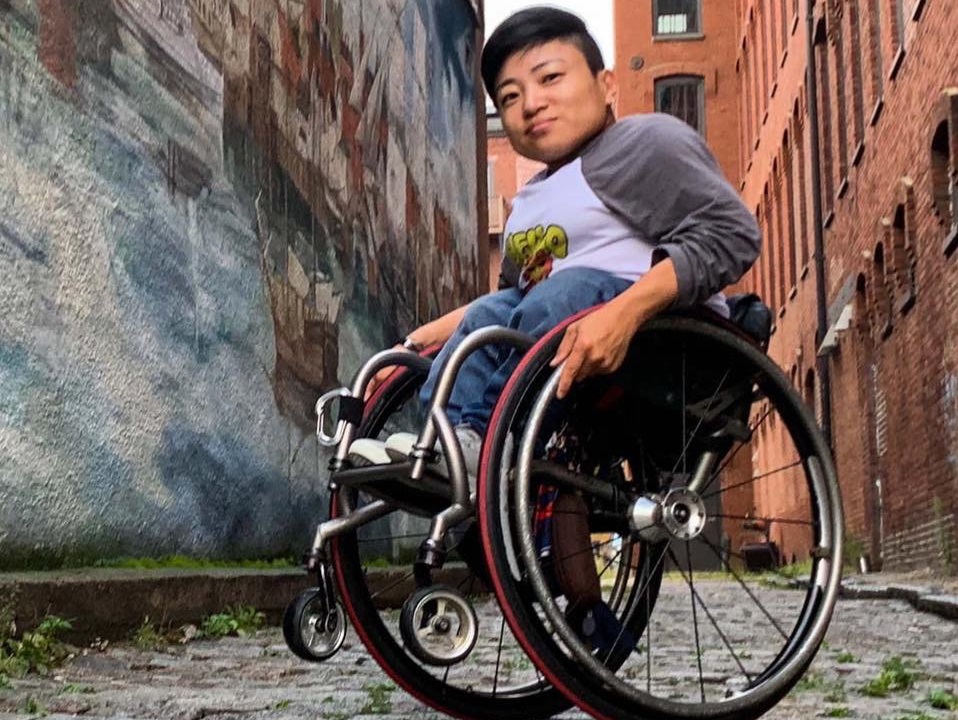
Los Angeles resident Sabrina Schroeder is among those complaining that outdoor dining, during the pandemic, has restricted sidewalk access for many mobility-impaired people.
Sabrina Schroeder knows that restaurants and bars, hoping to survive the pandemic, moved diners onto streets, sidewalks and other outdoor spaces.
Amid projections that expanded outdoor dining is here to stay — and a handful of cities creating new ways to ensure mobility-impaired people can access public spaces — Schroeder wants those establishments to leave enough room for her wheelchair to get around their tables, chairs and diners. That way, she won’t risk rolling into Los Angeles’ traffic-clogged streets.
 “With all the COVID rules, accessibility is often thrown out the door. It wasn’t great to begin with, but it’s become a really big problem,” said Schroeder, whose relatively mild cerebral palsy lets her maneuver a manual wheelchair.
“With all the COVID rules, accessibility is often thrown out the door. It wasn’t great to begin with, but it’s become a really big problem,” said Schroeder, whose relatively mild cerebral palsy lets her maneuver a manual wheelchair.
Across the country, many local governments threw a lifeline to struggling restaurants and bars by expanding rules on outdoor dining as COVID-19 continued. As pandemic restrictions are easing, many cities are grappling with how to meet the needs of those businesses without creating dangerous, potentially illegal obstacle courses for residents who use assistance dogs, wheelchairs, walkers or other mobility aids. Boston, by providing portable curb ramps for restaurants and bars whose owners asked for them, is among the relatively few cities that are implementing ways of assuring access.
Short of those kinds of efforts, diminished access is a problem that may outlast the pandemic. About 40% of full-service establishments have added outdoor seating since the pandemic began; and 84% of U.S. adults believe the new outdoor seating options should continue indefinitely, according to the National Restaurant Association,
Those data, in part, reflect a trend that started before the pandemic, said Brooks Rainwater, senior executive of the National League of Cities’ Center for City Solutions.

Brooks Rainwater is president of the National League of Cities’ Center for City Solutions.
“A great deal of the outdoor dining will persist post-COVID, particularly in some of our most dense cities,” said Rainwater, whose organization has about 2,500 member cities.
Responding to complaints about how outdoor dining was blocking access for the mobility-impared, officials in many of those cities have told businesses to make more room, he said. In addition to Boston, whose portable ramps come with an “accessibility toolkit” and a list of best practices, San Francisco, New York City and others also have taken special steps to protect access during COVID-19, though critics argue that few municipalities have done enough.
“Of course, none of this is perfect,” Rainwater said. “But I think cities are well aware of wanting to make sure the sidewalks and restaurants and everything else are ADA-compliant and doing what they can.”
Complying with the Americans With Disabilities Act, disability advocates say, will require businesses and governments to do more.
FLOUTING DISABILITY ACCESS LAWS
That law requires at least six feet of clearance on public pathways and access to curb ramps.
“It’s been quite evident that some of the restaurants aren’t paying attention to that,” said Mia Ives-Rublee, director for the Disability Justice Initiative at the Center for American Progress in Washington, D.C.

Mia Ives-Rublee is director for the Disability Justice Initiative at the Center for American Progress in Washington, D.C.
Furthermore, cities have generally done little to preemptively enforce the rules during COVID-19, she said. Many have issued permits, including expedited ones, for outdoor dining without physically inspecting the space, allowing businesses to self-certify that they meet requirements.
“And that has allowed for blatant violations of the ADA,” said Ives-Rublee, who uses a wheelchair herself.
Even with a hand-steered wheelchair that is much narrower than most battery-powered chairs, Schroeder said she still had trouble getting safely around some outdoor cafes in L.A because the space between tables was too narrow or a walled-off dining area completely blocked ramps leading from the curb onto sidewalks.
The situation there has improved over the past year, she said, as more businesses have become aware of the issue.
“In the beginning it was not good,” Schroeder said. “People just kind of threw their chairs around and were like, ‘OK, does this work?’”
The L.A. mayor’s office and city planning commission didn’t respond to Youth Today’s request for an interview or comment.
Angelo Amador, an attorney for the National Restaurant Association, said via email that the association helps its members “comply with the myriad of laws and regulations that cover the restaurant industry at a federal, state, and local level,” including the ADA.
“Of course,” Amador wrote, “the pandemic and the subsequent government orders that have restricted the use of many restaurant facilities — and for a large portion of last year closed restaurants altogether for both indoor and outdoor dining — have created a number of challenges.”
ACCESS IS AN ISSUE NATIONWIDE
Cities from coast to coast have changed their rules to encourage outdoor cafes during the pandemic.
In New York City, restaurants were allowed to apply for permits to use the sidewalk or curb in front of their business and self-certify that they met the space requirements, so they could open before undergoing a formal review.
Kansas City reduced its regulations to create temporary permits for outdoor seating on sidewalks, streets, small parks and parking lots, waiving the permit fee and some requirements for the number of parking spaces based on the maximum number of diners an establishment could serve at once. The city then approved 75 of the 108 applications it received to create a sidewalk or street cafe, according to an analysis by the Kansas City Beacon.
San Francisco enacted an outdoor dining expansion called “Shared Spaces,” which the city is now pondering making permanent.
Each of these three cities continued to require businesses to abide by the ADA, at least technically. But disability advocates say enforcement is uneven at best.
Ives-Rublee said there’s no firm data on outdoor dining and ADA compliance during the pandemic. But anecdotally, including in her own experience in D.C., it seems to be something cities are not enforcing, unless someone asks them to.
“Unless there are complaints, there’s not going to be a lot done about the situation,” Ives-Rublee said.
Schroeder said she doesn’t usually report issues she encounters in L.A. The one time she did email city officials a complaint about a sidewalk cafe blocking space, she didn’t get a response. But the next time she was in that area, the problem was solved.
But mostly, she just avoids the parts of her neighborhood she knows are clogged and tries to go around unexpected obstacles.
“I have such a mild disability and it was one of those things where I was just really understanding of the situation,” she said, adding that she personally knows a lot of struggling restaurant and bar workers. “It was, like, ‘OK, this is probably temporary.’ I don’t think anyone thought this would still be happening now.”
What cities can do
With outdoor dining here to stay in many places, Rainwater said cities must rethink their infrastructure and design, longterm.
They need to make their streets more people-centric, rather than car-centric, even if that means closing some streets to vehicle traffic entirely.
“The issue (of accessibility) really speaks more to sort of a broader need to create shared road spaces and build wider sidewalks,” Rainwater said. “Move toward pedestrianizing streets.”
In the meantime, Ives-Rublee said there are a number of things cities can do to better balance the needs of their restaurants and their disabled residents.
It starts with providing clear directions to business owners, then, engaging in education and outreach efforts, including printing materials about ADA regulations in various languages for restaurant workers. Then, they should provide a simple, fully accessible method for lodging complaints and act on those complaints promptly, Ives-Rublee said.
Ives-Rublee said cities should also have disability advisory groups to bring accessibility issues to the attention of city leaders.
Indeed, Schroeder said she thought many of the space issues in her neighborhood were unintentional, more due to overlooking than to disregarding the disabled population.
“Sometimes a person would see me trying to get through and that would be enough for them to change,” Schroeder said. “They just didn’t think about it.”





























